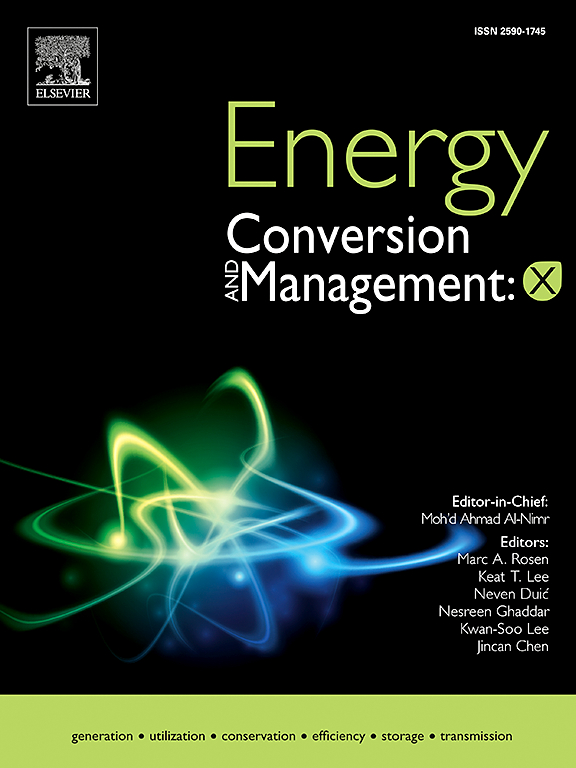Production of bioethanol from citrus peel waste: A techno – economic feasibility study
IF 7.1
Q1 ENERGY & FUELS
引用次数: 0
Abstract
The quest for sustainable and clean energy solutions has sparked considerable interest in alternative energy sources to mitigate the destructive impacts of climate change and reduce over dependency on fossils fuels. Among these, biofuels, particularly bioethanol, have shown great potential based on their renewable nature, non – toxic, biodegradability and low carbon footprint. Whereas there are various reported studies on bioethanol production for organic waste, comprehensive studies targeting the technical and economic aspects are lacking. Hence, this study explores the techno – economic feasibility of the production of bioethanol from citrus peel waste using a multifaceted approach that addresses the dual challenge of energy generation and waste management. The study provides an elaborative analysis of the composition of citrus peels; technical aspects of bioethanol production and evaluated relevant unit operations. The specific reactions that occur and the optimum conditions for the processes are determined. The economic viability of the process, considering a daily processing capacity of 450 metric tons of citrus peel waste is assessed. The profitability analysis indicates a Return of Return on investment (ROR) of 23.21 %, Discounted Cash Flow Rate of Return (DCFROR) of 25.15 %, net present worth of $ 84.94 million and payout period of 2.96 years. The findings demonstrate the technological and economic feasibility of producing bioethanol from citrus peel waste, highlighting its potential as a sustainable bioenergy solution with attractive environmental, energy and economic benefits.

柑桔皮废弃物生产生物乙醇的技术经济可行性研究
为了减轻气候变化的破坏性影响,减少对化石燃料的过度依赖,对可持续和清洁能源解决方案的追求引发了人们对替代能源的极大兴趣。其中,生物燃料,特别是生物乙醇,由于其可再生、无毒、可生物降解和低碳足迹的特点,显示出巨大的潜力。虽然有各种关于有机废物生产生物乙醇的研究报道,但缺乏针对技术和经济方面的综合研究。因此,本研究探讨了从柑橘皮废料中生产生物乙醇的技术经济可行性,采用多方面的方法来解决能源产生和废物管理的双重挑战。本研究对柑橘果皮的成分进行了详细分析;生物乙醇生产的技术方面,并评估相关的单元操作。确定了发生的特定反应和工艺的最佳条件。考虑到每天处理450公吨柑橘皮废料的能力,评估了该工艺的经济可行性。盈利能力分析表明,投资回报率(ROR)为23.21%,贴现现金流回报率(DCFROR)为25.15%,净现值为8494万美元,支付期为2.96年。研究结果证明了从柑橘皮废料中生产生物乙醇的技术和经济可行性,突出了其作为一种具有环境、能源和经济效益的可持续生物能源解决方案的潜力。
本文章由计算机程序翻译,如有差异,请以英文原文为准。
求助全文
约1分钟内获得全文
求助全文
来源期刊

Energy Conversion and Management-X
Multiple-
CiteScore
8.80
自引率
3.20%
发文量
180
审稿时长
58 days
期刊介绍:
Energy Conversion and Management: X is the open access extension of the reputable journal Energy Conversion and Management, serving as a platform for interdisciplinary research on a wide array of critical energy subjects. The journal is dedicated to publishing original contributions and in-depth technical review articles that present groundbreaking research on topics spanning energy generation, utilization, conversion, storage, transmission, conservation, management, and sustainability.
The scope of Energy Conversion and Management: X encompasses various forms of energy, including mechanical, thermal, nuclear, chemical, electromagnetic, magnetic, and electric energy. It addresses all known energy resources, highlighting both conventional sources like fossil fuels and nuclear power, as well as renewable resources such as solar, biomass, hydro, wind, geothermal, and ocean energy.
 求助内容:
求助内容: 应助结果提醒方式:
应助结果提醒方式:


